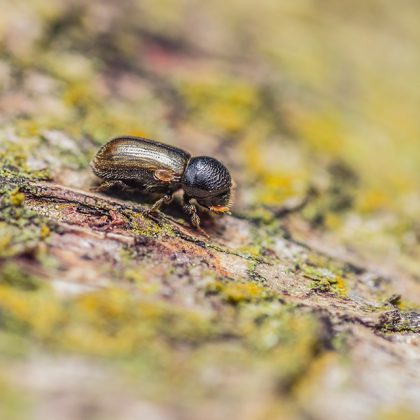New fossil, Domipteron, sheds light on net-winged beetle evolution
Net winged beetles (Lycidae) are cosmopolitan pollinators, known for their intricate vein-like wing patterns and eye-catching colours, but behind these diverse delicate beetles lies an evolutionary enigma. Several conflicting tree topologies have been reconstructed within the family Lycidae as a whole, both from morphological and molecular based studies, making their true evolutionary history unclear.

Two particularly puzzling tribes of net winged beetles, Calopterini and Eurrhacini are well known in the Americas from both the fossil and extant record. However, their phylogenetic relationships have been grossly entangled and difficult to recover due to lack of fossil specimens and their multiple specialised characteristics. Initially, Eurrhacini was placed within the broader Calopterini tribe because of their remarkable resemblance to one another. Later studies based on molecular data found the two lineages to not be sister lineages (that is split from the same node). Although they can also be morphologically distinguished by their different male genitalia on adult specimens, the mystery of the link between these two groups remains.
A new fossil specimen, Domipteron gaoi n. gen. n. sp. was recovered from the Miocene-aged Los Branchos amber mine in the Dominican Republic, adding to the already sparse record of Calopterini, with only one other species recovered from Dominican amber previously. Unsurprisingly, this specimen displays characteristics of both the Calopterini and Eurrhacini, further demonstrating that more work is needed to clarify the phylogenetic placements of these lineages, using both larger morphological and molecular datasets.
In this study, Yan-Da Li and colleagues used cutting-edge confocal and micro-CT imagery to examine the specimen’s morphology with extraordinary detail. Despite the lack of preserved genitalia in this specimen, a feature previously used to distinguish the two tribes, their phylogenetic analysis assigned the specimen to the subtribe Acroleptina, which sits within Calopterini. This result is further supported by the fact that Calopterini is often found biogeographically in the West Indies, whereas Eurrhacini is more restricted to mainland South and Central America.

Although this assignment yields an interesting insight into the characteristics of Calopterini, the authors caution that more work would be needed to evaluate the robustness of this outcome. Nonetheless, this beautiful new fossil specimen of Domipteron adds to a growing collection of Dominican amber species which could help elucidate the subtle differences between Calopterini and Eurrhacini, and more broadly their evolutionary relationships within the net winged beetle family Lycidae.
“Domipteron, a new genus of Calopterini from Miocene Dominican amber (Coleoptera: Elateroidea: Lycidae) ” by Yan-Da Li and colleagues has been published in Journal of Paleontology, published by Cambridge University Press on behalf of the Paleontological Society. The article has been made freely available for a limited time.






